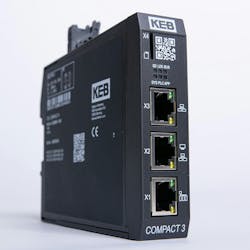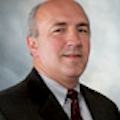Key highlights
- The C6 Compact 3 offers a flexible, future-proof control solution based on Linux and containerized technology, allowing for easy addition/removal of functionalities like OPC UA and robotic motion control without reboots.
- It supports IEC 61131-3 languages and is designed for brand-agnostic interoperability, ensuring machine code and communication are not tied to a single hardware platform, enhancing flexibility in designs.
- This compact controller can serve as either a complete machine control for small applications or a dedicated motion sub-controller in larger systems, and it enables remote updates and troubleshooting for both KEB and third-party devices via the NOA platform.
KEB America's C6 Compact 3 is the next generation of control in its ecosystem. It is based on the Linux operating system (OS) and offers an open architecture. The container-based technology allows software functions to be integrated and organized, and the controller can be programmed using IEC 61131-3 languages.
The C6 Compact 3 is 25 x 100 x 132 mm and DIN-rail-mountable, and it operates on 24 Vdc in temperatures ranging from -20 °C to 55 °C.
“The C6 Compact 3 was created as part of our Next Open Automation (NOA) platform, which fulfills several customer needs,” explains Scott Cunningham, product and application manager, controls and automation, at KEB America. “The foremost need is the possibility to provide functionality and security updates via our NOA ecosystem as new regulations and requirements go into effect around the world. Customers can simply connect their device to the internet, log in to the web-based portal and view required and available updates and activate them. Furthermore, with our NOA Portal fleet management functionality, the customer can perform these functions from one central location, saving them from on-site maintenance.”
Product flexibility was another need the device aims to fill. “With the C6 Compact 3, customers can add or even remove functionality as needed,” says Cunningham. “As part of the NOA world, functionality is defined by which ‘apps’ are installed on the device. If the customer needs OPC UA, just add it. If the customer needs Helio, just add it. If the customer needs robotic motion control, just add it. If the customer decides to switch to our X1 Web HMI and use Helio on the X1, just remove it from the Compact 3 and install it on the X1. Ultimately, the customer only needs to know the hardware needs at time of order.”
Cunningham describes the idea of OPC UA as the communication version of what PLCopen stands for. “Ultimately PLCopen gives machine builders the chance to have their machine code not be tied to a particular hardware platform—basically, open, defined and peer-improved. OPC UA is a communications platform that is not tied to a brand, is secure and is improved by the same people who need it and use it.”
KEB identified a need for small, economical motion-based and coordinated motion controls that can be programmed using IEC 61131-based languages. “The C6 Compact 3 fits in that space perfectly,” explains Cunningham.
IEC 61131-3 languages are not new to KEB. “We adopted it at the start of our controls program and have seen users become more comfortable with the different languages and their application,” explains Cunningham. “It fits with KEB’s goal to provide our customers flexibility instead of siloing into one ecosystem. This was reinforced with the global production disruption.” The companies most affected were the ones that were tied to one single brand because the programming code was brand-specific.
The concept of small, motion control within the NOA space started about five years ago. Physical development took place about three years ago, with the product certifications attained in 2025.
The design comes from the C6 Compact lineage, which originated around 20 years ago, and is a modernization of the C6 Compact II. “This product line is our single-board motion control, traditionally embedded,” explains Cunningham. “To meet growing features and security needs, we moved to Linux, an OS-based solution.”
The Compact 3 is designed to be industry-agnostic. “The platform is continually showing us how adaptable it is to motion-based and non-motion-based applications,” explains Cunningham.
“Linux provides many advantages over other embedded/OS platforms,” says Cunningham. “First and foremost is the ability for KEB to support ourselves if a problem arises. We no longer have to sit and wait, and often hope, for a bug fix. If there is an issue with a hardware driver or a security update, we can make changes to the Linux core. Of course, this also means that we share this improvement to the Linux source. This concept of use, improve and share is multiplied over all of the Linux users and developers in the world. While this meant we had to become Linux experts, we felt this was a huge advantage and the payback outweighed any front-end effort. Secondly, licensing fees for paid OS systems would have made a solution like the C6 Compact 3 not even viable.”
The unit is designed for two main use cases. “For compact machines, the Compact 3 can be the whole machine control, working with the full KEB product offering of remote I/O, drives and gearmotors,” says Cunningham. “It really allows the customer to one-stop shop their automation needs. In larger, more demanding machines, the Compact 3 can be the motion sub controller, removing the demanding motion control needs from the main machine PLC, removing complexity and cost of motion cards and licenses.”
KEB is also working on using the unit as a communications gateway and even as the next generation of its C6 Router remote access line. “The C6 Router is a huge hit with our customers as it allows them to remotely troubleshoot and update any device on the machine network—KEB brand or not,” says Cunningham. “Using the Compact 3 as a remote access device would bring the customer’s whole machine into the NOA remote access environment, allowing them to update/upgrade the KEB devices and other branded devices on their machine in one central location.”
A big part of KEB’s implementation of the OS side of its next-generation controls, such as the Compact 3, is the usage of containers. “Each NOA application is a container running on the operating system,” explains Cunningham. “It is completely isolated from any other containers and can easily be installed or removed with a click of a button. Most importantly, the control does not need to be rebooted. Customers can even create their own containers and install them without worrying about affecting the motion control or any other application running.”
Interoperability is at the core of KEB’s product designs. “This is deeply rooted in the KEB history,” says Cunningham. “When we introduced our first frequency inverters, we did not offer any motors, so from the start we designed the product to run anybody’s motor. This idea of flexibility for the customer has not changed and is no different with the C6 Compact 3.” The device is designed to control and communicate with both KEB and non-KEB products, and it can add both KEB and user-created functionality.
“You can see a common thread here, whether it is Linux, IEC 61131/PLCopen or OPC UA. They are all brand-agnostic, peer-reviewed, maintained and improved,” notes Cunningham.
“The Compact 3 is just one piece of our new controls and automation solutions, yet we are already seeing the strong flexibility in the product not only providing control solutions, but as a gateway and a remote access device,” says Cunningham. “With our NOA platform, new functionality isn’t stuck waiting for hardware development. Once new functions are created, just add it via NOA.”
About the Author
Mike Bacidore
Editor in Chief
Mike Bacidore is chief editor of Control Design and has been an integral part of the Endeavor Business Media editorial team since 2007. Previously, he was editorial director at Hughes Communications and a portfolio manager of the human resources and labor law areas at Wolters Kluwer. Bacidore holds a BA from the University of Illinois and an MBA from Lake Forest Graduate School of Management. He is an award-winning columnist, earning multiple regional and national awards from the American Society of Business Publication Editors. He may be reached at [email protected]


